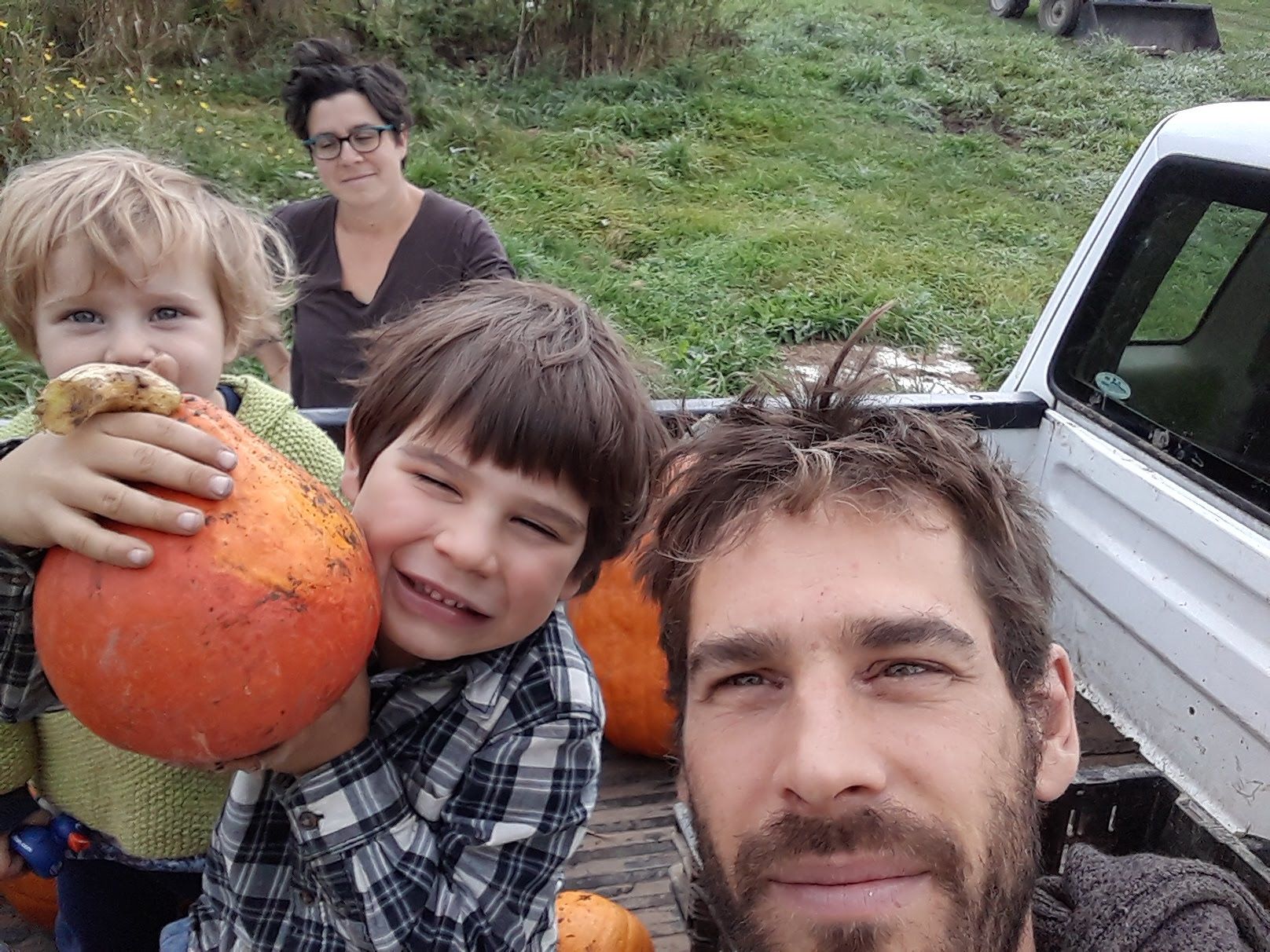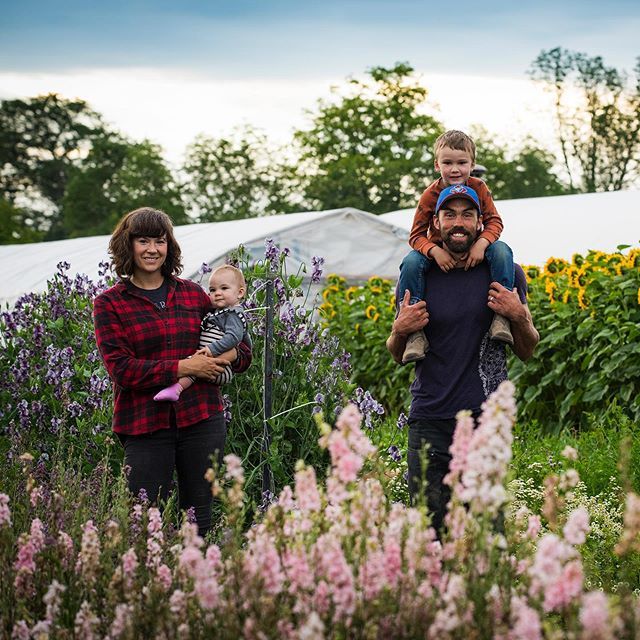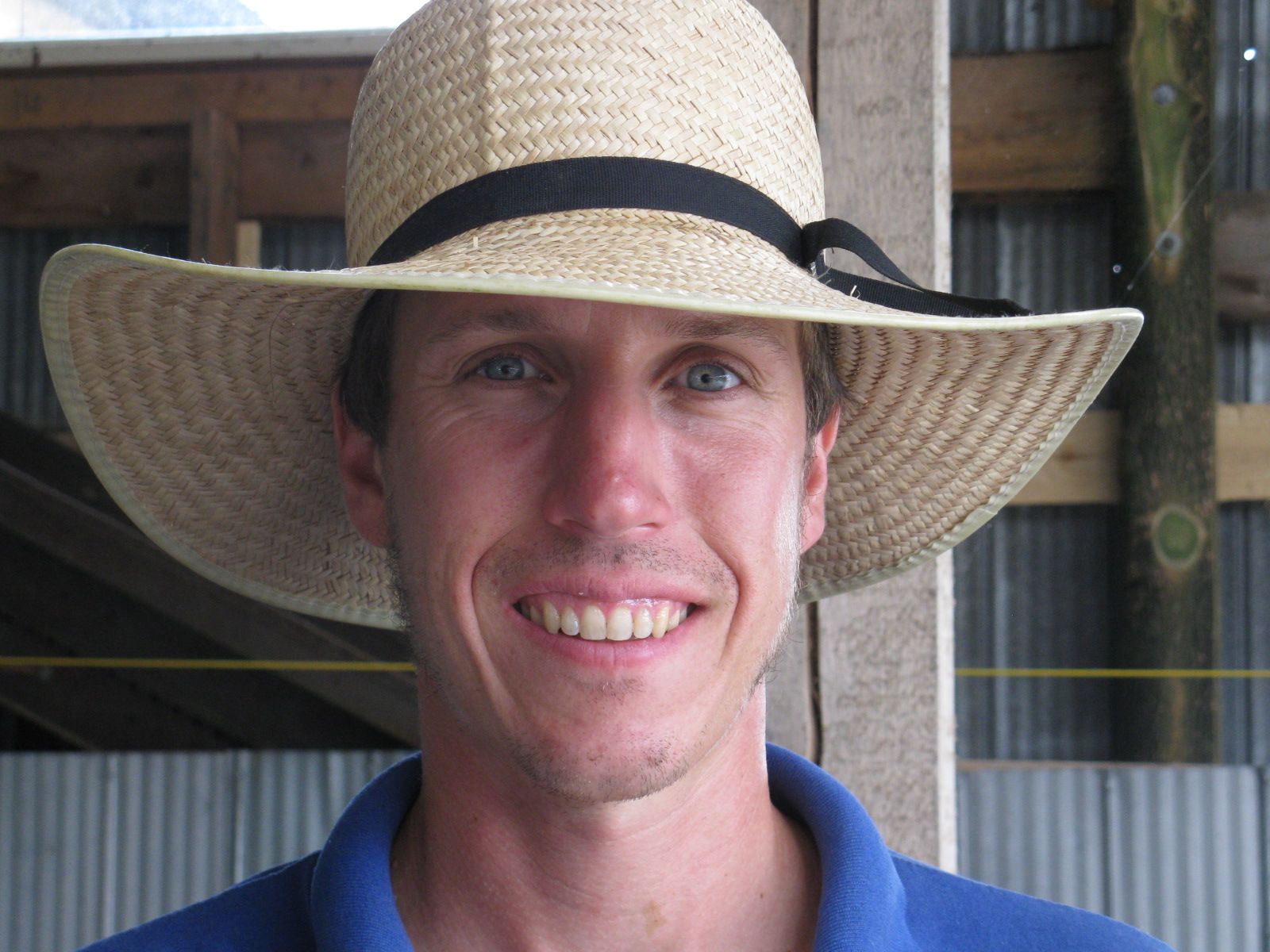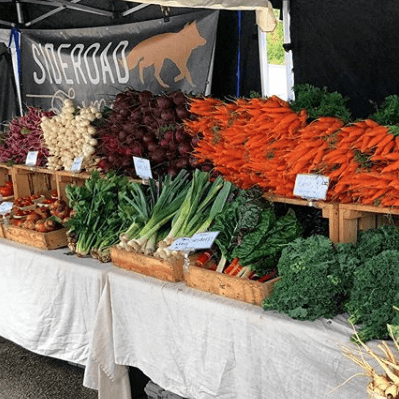Community Supported Agriculture (CSA) is becoming an increasingly popular farming structure. While the structure is clear – selling shares of a farm’s products or harvest – there are many innovative models. With the goal of sharing some CSA innovations with you, we interviewed four vegetable farmers who offer a CSA so that we might offer perspectives for those who are considering offering a CSA or are looking for new ideas and inspiration.
Leslie Moskovits of Cedar Down Farm

cedardownfarm.ca | Facebook: @cedardownfarm
Leslie and Jeff Boesch, along with their two young children, grow certified organic vegetables and herbs for spring, summer and winter farm shares on their farm in Neustadt.
Elaine O’Sullivan of Grand River Gardens

grandrivergardens.ca | Instagram & Facebook: @grandrivergardens
Elaine offers an organic vegetable and herb summer CSA on a family farm in Grand Valley.
Their farm also includes a dairy goat operation, an on-farm store and a pasture-raised pig and chicken operation.
Amy Kitchen of Sideroad Farm

sideroadnaturalfarm.com | Instagram & Facebook: @sideroadfarm
Amy co-owns Sideroad Farm with her husband Patrick and their two children in Walters Falls. They grow certified organic veggies, flowers and pasture-raised chicken and eggs.
Daniel Brisebois of Tourne-Sol Co-operative Farm

fermetournesol.qc.ca | Instagram & Facebook: @fermetournesol
Daniel is a founding member of Tourne-Sol Co-operative Farm along with 6 other co-op members and 7 additional employees. They grow organic vegetables as well as organic seeds for their online seed store and retail seed rack program. Tourne-Sol is located in Les Cèdres, QC.
EFAO: How long have you been running your CSA? How many members did you start with and how many do you currently have?
Leslie: We’ve been running it for 10 years. We began with 75 summer and 35 winter shares and now have 205 summer, 110 winter and 120 spring share members.
Elaine: This is my 3rd year and I operate my CSA on a part-time basis. I began with 11 members and am now up to 20.
Amy: We started 6 years ago with 20 members and in 2019 we had 85 members.
Daniel: We started with 110 shares 14 years ago and currently we have 500 shares.
EFAO: Why did you decide to run a CSA from your farm?
Leslie: CSA has always been our choice as a community-based farm structure. It builds in financial security for the farm and builds community. We love the way it teaches people about food and re-creates a farmer/community relationship.
Elaine: I have a passion for sustainability, a passion for food sovereignty and a passion for healthy living.
Amy: Cash flow primarily…the idea of helping to offset season start-up expenses was what initially brought about the CSA and likely what has kept it going.
Daniel: We had worked on previous CSA farms and had experience with the model. CSA is a great way to have cash flow early in the season and be able to plan what we would grow. CSA is also a great way to build strong relationships with your eaters.
EFAO: How did you determine the proper scale/share number for your CSA and how has this evolved over the years?
Leslie: We have always had a vision of a CSA around the size we are at now (205 summer shares) but ultimately have made decisions on scale and numbers based on efficiently using our infrastructure, for example, starting the spring share to make the most use of our hoop houses, and how much labour we could effectively attract and manage as well as our required income. We also made the decision based on our ability to market and deliver the CSA using the same labour and infrastructure instead of having to hire additional help.
Elaine: I was most nervous about this decision when I first started. I worried about not having enough for all my CSA members. For me, running the CSA part-time, I decided to start small and see what it took to grow enough for those 11 members in Year 1. I also kept in mind that for the first year I would need a lot of time and energy to get the garden and infrastructure set up for the longer term. I found it was important to think about what vegetables to offer for the first few spring shares when there are often limited options for fast-growing veggies and ensure I didn’t “over-commit” to members. Year 2 I felt confident with the infrastructure set up and a rhythm to my work that I could serve double the number of members. Year 3 I kept the number around the same because I found I was running at max capacity. Next year I am looking to hire an intern and increase membership by another 50%.
Amy: We prefer a CSA that is a minor part of our [overall] operation so that we can be sure to always have enough product to fulfill our CSA requirements. We have grown slowly. We always sell out [of our CSA shares each year] so now set a number that we feel our team can reasonably harvest and pack in one day.
Daniel: We started based on our [collective] experience on other farms and expanded slowly year by year. Though we started with 110 baskets per week, I would not recommend this to most new CSA farmers. We were 5 people with solid farming experience.
EFAO: Are your shares customizable or set? (i.e. what kind of choice do members have and how is this managed?)
Leslie: Our shares are customizable. We set up a market-style pick up whereas many items as possible can be swapped. We aim to make everything tradeable so that people can take only what they want and only limit things that we need to because limited numbers or the value [of that vegetable] being too high to allow for swapping.
Elaine: Shares are set but I do offer a swap bin at drop-off locations so members can exchange something they don’t like for something they do.
Amy: We are fully customizable using a CSA software called Farmigo. We create a “Farmers’ Choice Box” each week using the software and then invite our members to login to their accounts to customize their share for that week from the list of produce available.
Daniel: Our shares are semi-customizable. We offer 9-12 items [per share] each week with two or three choices the items. We also offer an exchange box to swap some items.
EFAO: Do you offer your farm products for sale through other markets? (i.e. farmers market, wholesale, retail) How does this work with your CSA model?
Leslie: We sell additionally to one restaurant and one retail store. We also have an online store where we sell our own extras and other farmer’s products that we do not grow (like honey, meat, and fruit). These sales are harvested during CSA harvests and delivered on the same evening as CSA pickups.
Elaine: Currently if I have extra produce I sometimes sell it through the farm store – “Landman Gardens & Bakery”. I would like to develop a relationship with some local restaurants in the future to sell more of the abundant items.
Amy: We also sell at the farmer’s market, at our on-farm store, and we do a small number of wholesale and restaurant accounts. It all works…we spend way too much time harvesting…but we have somehow managed to make it all work.
Daniel: We used to go to farmers’ markets but have since decided to only sell vegetables through our CSA. We also run a seed company. We have an online store and go to Seedy Saturdays throughout Quebec and Ontario.
EFAO: How and where do CSA members receive their shares?
Leslie: Our members come to a set location once per week. We deliver to 3 separate locations and set up for 2 hours at each location. We pay a rental fee at all locations.
Elaine: Currently our shares are packed in baskets and members can pick up at our farm on Thursday evenings or we do a drop-off in Orangeville on Monday evenings in the lobby of a supportive business.
Amy: Members pick up [at designated off-farm] locations (members’ homes or the Collingwood Farmers Market). In the winter we offer home delivery for a fee ($5).
Daniel: 200 of our members pick up directly on the farm. The remaining members are split over 3 off-farm locations. At the pickup, items are displayed in market-style bins with a list for folks to follow.
EFAO: Do you sell other producers’ products through your CSA? If so, what lessons have you learned about the best way to do this?
Leslie: We sell other producers’ products through an online store that we started in 2019. In the past, we have just brought these products to pickups and sold them there. It works better for us to just buy and re-sell products with a small mark-up. But as of yet, the online store has not been a boon for sales (i.e. if we bring local strawberries to our pickup they sell out but people buy way less through the online store). We will continue to try and make the online store work as it is much better for taking and tracking orders and payment but can’t make a final judgement on this method. In the past bringing products to our pickups and selling there has been good for moving more quantity but bad for tracking payments and questionably worth our time when we don’t have a set mark up.
Elaine: We offer locally-roasted coffee and free-range eggs as an add-on item from other local producers. The best way I’ve found to do this is to ask people to commit when they first sign-up [for the CSA] to a frequency or a number of weeks they would like to receive the item. This way, payment can be made in advance and I don’t have to order things at the last minute.
Amy: In the winter we do a Winter Bounty Box program that is similar to a CSA with some unique/more flexible features. In the winter we offer meat, bread, maple syrup, honey, chocolate, coffee as well as our veggies, chicken and eggs.
Daniel: We offer sweet corn, potatoes, and broccoli that is purchased from other organic producers. We’ve learned that not all organic producers prioritize quality and that once we found good producers we need to hold on to them! We also offer a fruit share with fruit bought from organic growers. We also sell flowers, honey, oil, cheese from other producers.
EFAO: What is your farm’s biggest challenge with the CSA model?
Leslie: Exhaustion. Not having enough labour to meet our needs which leads to stress.
Elaine: Pleasing everyone.People are busy and it can be hard for them to commit to a regular pick up on a set day. We try to be flexible and accommodating but sometimes it just doesn’t work.
Amy: Getting members to return their bins/follow the rules/read information clearly laid out in newsletters and on the website. It honestly runs pretty smoothly. The changes we have made to make things super flexible are a big hit with our members.
Daniel: We have a special order system for CSA members to order extra stuff. It is very popular with clients but a headache for us. There is a surprising amount of admin associated with tracking whether orders were picked up and dealing with different payment methods. We are trying to find ways to make this easier for us!
EFAO: What has been your most successful CSA marketing strategy?
Leslie: Growing high-quality vegetables and having beautiful, abundant shares. Working to ensure customers are happy and fully satisfied through the aforementioned quality and quantity. Making sure customers can choose what they want and growing what they want – being observant about what they want and making sure that’s what they get. Otherwise, we do essentially no marketing.
Elaine: I think for us it’s having a presence in the community. When I meet people at different workplaces or events and they get to know me I tell them about our CSA. People seem excited to learn about it and then it’s more personal which is what I like. I want people to feel connected to their food and for that, it’s important that they know their farmer.
Amy: Farmers markets are what initially seeded our CSA members – I think it was important for people to meet us so that they could build that trust before investing in a membership. Now it’s all word of mouth. I don’t bother marketing or mentioning our CSA much because it seems to fill up quite quickly.
Daniel: Word of mouth. Our current thrilled members are our best ambassadors.
EFAO: Do you have any advice for a farmer looking to start or expand their own CSA?
Leslie: Make sure your vegetables are high quality, clean, beautiful and that you are growing what your customers want. Stop growing things they don’t want and make sure they are never being forced to bring home something they don’t want (ie in a packed share that is not customizable).
Elaine: Do what you love. Love what you do. Every day.
Amy: I’d recommend getting a few years growing under your belt before offering a CSA. Once you have figured out production, then start small. Communication is key…people want to feel a connection with the farm via newsletters, personal contact etc. but you should also be asking your members what they want. Are they happy with the quality/amounts/diversity, etc? Don’t overwhelm with too much of any one thing. Grow more “normal” veggies.
Daniel: Start Small and develop strong relationships with your clients. Don’t grow too fast. Get to know your clients!

